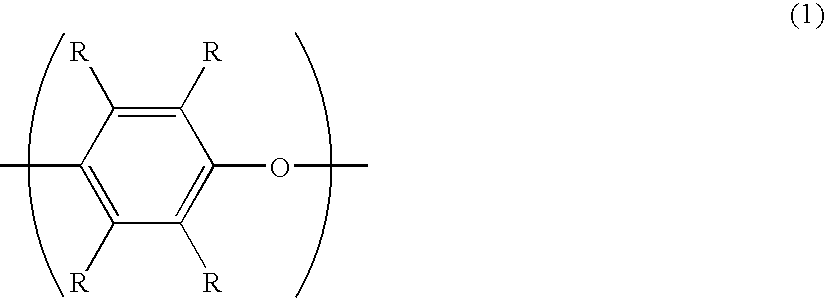Resin Composition Having Excellent Heat Resistance
a technology of composition and heat resistance, applied in the field of resin composition, can solve the problems of increased production cost, increased production cost, and reduced lamp luminance, and achieve excellent fogging resistance, excellent impact strength and fluidity, and high appearance
- Summary
- Abstract
- Description
- Claims
- Application Information
AI Technical Summary
Benefits of technology
Problems solved by technology
Method used
Image
Examples
examples
[0236]The present invention will now be described in more detail by the following examples and comparative examples. However, the present invention is in no way limited to these examples and comparative examples.
(Used Raw Materials)
1. Production of the Aromatic Polyamide (Polyamide 9T)
[0237]Following the method described in the Examples of JP-A-2000-103847, terephthalic acid as the dicarboxylic acid component, 1,9-nonamethylenediamine and 2-methyl-1,8-octamethylenediamine as the diamine component, and benzoic acid as the terminal-blocking agent, sodium hypophosphite monohydrate as the polymerization catalyst and distilled water were charged into an autoclave, which was then closed (the moisture content in the system was 25% by weight). After the autoclave was thoroughly purged with nitrogen, the mixture was stirred for 2 hours and the internal temperature was increased to 260° C. In that condition, the compounds were reacted for 1 hour. The internal pressure at this stage was 46 atm...
examples 1-10
Present Invention
[0264]Using a twin screw extruder with one feed opening in the upstream and one feed opening in the middle of the extruder (ZSK-25, manufactured by Coperion, Germany), and with the temperature from the upstream feed opening to the middle feed opening set to 320° C. and the temperature from the middle feed opening to die set to 280° C., 40 parts by mass of PPE-1, 10 parts by mass of SEBS-1 and 0.4 part by mass of MAH were fed from the upstream feed opening at a screw rotation speed of 300 rpm and an output of extruding of 15 kg / h. The mixture was melt-kneaded, and then 50 parts by mass of PA9T and 0.05 part by mass of Talc-1 were fed thereto from the middle feed opening. This mixture was extruded and cut to produce a resin composition pellet. It is noted that the SEBS and MAH were used as a mixture mixed by a tumbler, and that the PPE was fed into the extruder using a separate feed apparatus from these materials. Further, the PA9T and the Talc-1 were used as a mixtur...
examples 11 to 13
Comparison
[0276]Extrusion, molding and evaluation were carried out in the same manner as Example 1. The only difference was that the polyamide 9T was not used together, but was used alone. The intrinsic viscosity of the PA9T used in Example 11 corresponded to Example 1, and that of Examples 12 and 13 corresponded to Examples 2 and 7 respectively. The obtained results are shown in Table 1.
TABLE 1ExampleExampleExampleExampleExampleExampleExample1234567PresentPresentPresentPresentPresentPresentPresentinventioninventioninventioninventioninventioninventioninventionPA9T(Intrinsic viscosity [η]: 0.7)Part by mass4030PA9T(Intrinsic viscosity [η]: 0.8)Part by mass30PA9T(Intrinsic viscosity [η]: 0.95)Part by mass40201520PA9T(Intrinsic viscosity [η]: 1.0)Part by mass25103035PA9T(Intrinsic viscosity [η]: 1.1)Part by mass10PA9T(Intrinsic viscosity [η]: 1.2)Part by mass2520PA9T Mixture intrinsic viscositydl / g1.10.951.01.00.950.80.8SFDcm4272635085135124Izod impact strength (23° C.)kJ / m2382627283716...
PUM
| Property | Measurement | Unit |
|---|---|---|
| particle size | aaaaa | aaaaa |
| thickness | aaaaa | aaaaa |
| total light transmittance | aaaaa | aaaaa |
Abstract
Description
Claims
Application Information
 Login to View More
Login to View More - R&D
- Intellectual Property
- Life Sciences
- Materials
- Tech Scout
- Unparalleled Data Quality
- Higher Quality Content
- 60% Fewer Hallucinations
Browse by: Latest US Patents, China's latest patents, Technical Efficacy Thesaurus, Application Domain, Technology Topic, Popular Technical Reports.
© 2025 PatSnap. All rights reserved.Legal|Privacy policy|Modern Slavery Act Transparency Statement|Sitemap|About US| Contact US: help@patsnap.com



